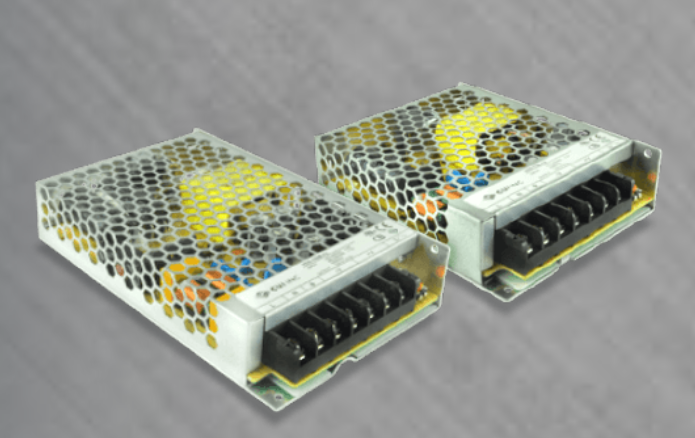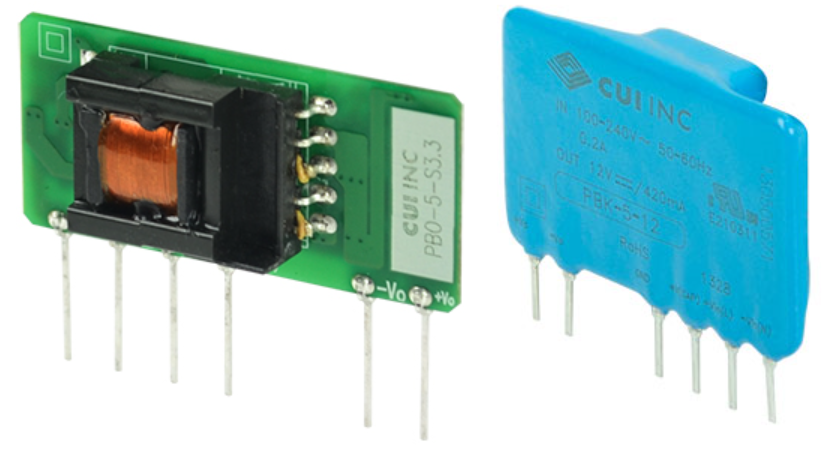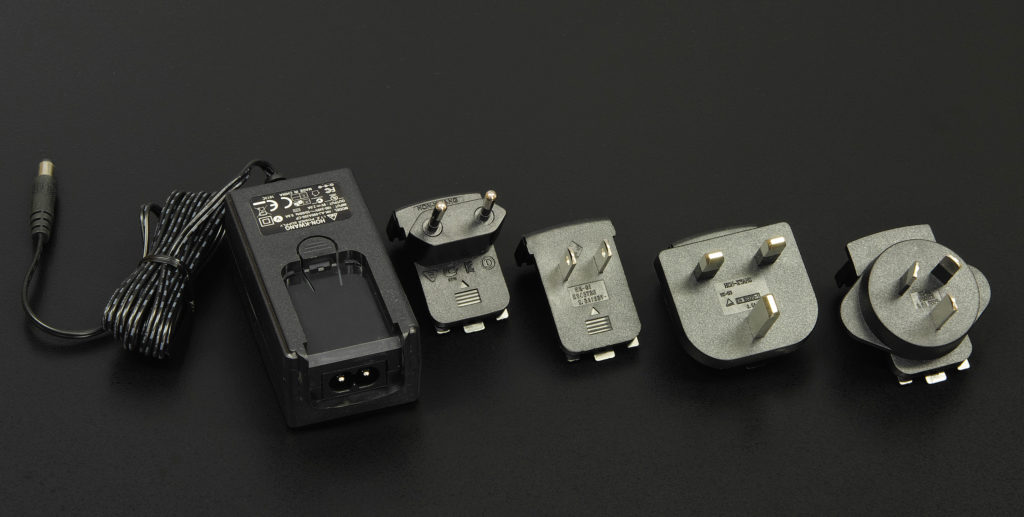Even if you never plan to go beyond one prototype, you still need to wean your board off the bench top power supply. However, choosing a permanent power supply for your electronics design is more than just a simple exercise in determining the operating voltage, maximum current, and form factor. Mouser Electronics has over 43,000 power supplies to choose from. A parametric search enables you to quickly sort power supplies by specification values. And although no parametric search can even the playing field across all manufacturers, since they might characterize based on different test conditions, it’s much better than leafing through several different manufacturer catalogs and whittling the list from there.
Since most power supplies are of the Switched Mode Power Supply (SMPS) type, factors in selecting an SMPS will be the topic here. When selecting an SMPS, you will need to know input voltage, output voltage, maximum current draw, form factor, and purpose (for regulatory reasons) of the power supply. You may also need to consider other features, such as the intended operating environment, whether you will need extras like integrated fuses, and whether the SMPS will be external and if so, what type of connector will it need for your Printed Circuit Board (PCB).

Form factor
Your selection might start with power supplies lumped into similar categories such as SMPS, AC adapter, or modular power supply module. Start narrowing down the selection based on form factor. Is it internal or external to the chassis? Is physical size an issue? SMPS can be enclosed in plastic or metal or mounted in a rack or on a DIN rail inside a chassis. The most ubiquitous power supply today is likely an external “wall wart” with a USB connector. Laptop (a.k.a. desktop) power supplies are also external but tend to have a barrel connector on the business end (which may change in the coming decade as USB-C can handle up to 100 Watts). Other SMPS can be open frame, or an open PCB that you can mount inside a chassis.

A PCB-mounted SMPS will be either open frame or “potted.” A “potted” device usually means that the device (or component) is enclosed in a capsule and filled with potting compound to provide protection against outside elements like moisture, corrosive elements, shock, and vibration. (Encapsulation is similar and is more like a dip coating for protection of components, see Figure 3.) Specialized power supplies might be high-wattage rack-mounted supplies for labs or servers, or SMPS that are rated for medical equipment (with low leakage current.) Medical power supplies isolate internal voltage from line (wall outlet) voltage and are designed to meet the very stringent IEC 60601-1 requirement.[i] All power supplies on the market should be in compliance with regulations of the country where they are sold (usually marked by a symbol like CE, UL, CSA, and others).

Specifications: The datasheet
After deciding on one or more acceptable form factors, make a list of the basic requirements or specifications. If the power supply is to draw power from the grid, the line voltage might be 120VAC or 240VAC, depending upon what country you are in. For external SMPS, wall plug configurations vary across different countries. Moving away from the wall plug, consider the shape, size, and location of the “brick,” “wall wart,” or power module. Will it need to stick to a lower budget by plugging directly into the wall (wall-wart style), or will it have a separate cord that attaches to the power module (desktop style)? Consider the length of the cord and the type of connector (e.g., barrel, USB) that connects it to the power module, unless it’s hardwired directly into the electronics device. A wall-wart is a power module that has VAC prongs that protrude out of the module, and the cable is often not detachable unless it’s a USB cable. The other end of a power module or brick-type enclosed power supply is another connector that attaches to the electronics device (another spec).

You need to know how many outputs the power supply will need. If it’s more than one, you likely have a power supply module that mounts inside a PCB or a rack. What are the voltage levels that the power supply must provide? How well-regulated is the voltage coming off the SMPS? How much wattage will you need for the SMPS output(s)? What is the operating temperature of the intended environment for the power supply and what do the specifications rate for nominal and maximum operating temperatures?
SMPS specs: the shortlist
| Plug/Connector Style | Wall plug, USB, barrel, etc. |
| Voltage | How many outputs are needed and at what levels? Is it adjustable? Make note of the voltage tolerance of the SMPS and determine if your electronics design can withstand that margin of error. |
| Current Range | An SMPS needs a load, so if your device shuts itself down, make sure that the SMPS can tolerate 0A on the low end. |
| Wattage | Power = Voltage x Current |
| Rated Current | What is the max. power supply current within the specified temperature range? |
| Noise | How much noise does the SMPS introduce? If you need very low noise, consider a Linear Power Supply, not an SMPS. |
| Efficiency Rating | Efficiency figures are stated differently between data sheets. Make note of the conditions in which testing was done for specified figures on efficiency, as “specsmanship” is part of every data sheet. Efficiency, listed as a percent, is the ratio of output power to input power under a known load current and nominal line conditions. More efficient SMPS also means less heat is generated. |
| Start-up Time | An SMSP actually needs a few fractions of a second to develop a stable output voltage. If you already have a supervisory circuit to delay MCU start-up, then you needn’t be concerned about this spec. |
| Line regulation/Dynamic response | This spec is a measure of how well the SMPS regulates the spikes and dampening of the electricity coming out of the wall. If your design isn’t set up for regulating the voltage levels it receives, then this is an important specification. |
| Load regulation | Load regulation is a measure of how stable the voltage level is coming out of the SMPS and into your device. If you have heavy loads that come and go, especially at maximum rated voltage levels, you may want to pay attention to how the SMPS can maintain a steady voltage output level. Usually listed as a percentage. Lower is better. |
| Hold-up Time | The amount of time that the power supply can maintain a consistent nominal output voltage level after it’s input voltage (source) has been removed. Prevent interferences in case of sudden short circuit, overload, power outages, voltage sink in the power system. Helpful in preventing interference in case of unexpected overload or source sinks/outages on the input side. In an outage, a transition to an Uninterrupted Power Supply would fail if the SMPS has cheap capacitors that do not hold up the output long enough (~20ms) for the UPS to kick in. (UPS are often used in regions where utilities are unstable.)[ii] |
| Range of Frequency and Voltage on the Input side | What is the range of frequencies the SMPS can tolerate? Line frequency is usually 50Hz or 60Hz. The range of the voltage that the SMPS can tolerate could be universal, e.g., a power module that can operate from 85 – 240 VAC. Or not. Read the data sheet. |
| Leakage Current | A small amount of current that flows through alternate pathways, circuit protection devices, insulators, and components. Leakage current is a physical phenomenon that wastes energy. Acceptable leakage current in the IT world is 3.5mA for an SMPS and 0.5mA for medical. |
| In-rush current | In-rush current is a sudden large flow of current that exceeds the usual, steady-state operating current, most often associated with turning on the power supply. You will need to consider in-rush current to size a fuse. |
Integrated protection
A quality power supply will have built-in circuit protection against overvoltage, overcurrent, and temperatures that exceed tolerances. Overvoltage can manifest as transient spikes on the DC (output) side of an SMPS, which can ruin a chip. A transient voltage diode or similar component would protect the electronics from any spikes the SMPS might receive or fail to regulate. Overcurrent can occur when the load on the SMPS draws more than is rated. In case of overcurrent, an SMPS with overcurrent protection would either shutdown (blow a fuse, negative temperature coefficient thermistors, and special circuits). Most power supplies will have protection to shut down when internal temperatures get too high. Of the last in a datasheet are graphs showing the relationship between maximum output power and ambient temperatures (temperatures outside the power supply) called de-rating curve.
The process of choosing a power supply involves balancing trade-offs so that everything is within expected tolerances with a healthy margin for error. Power supplies can be purchased for cheap on eBay and the like, but beware where you purchase and who you buy from. An authorized distributor is your best bet, since a distributor that is authorized to sell by the power supply manufacturer will have something like a chain of custody for products that it sells.
My controller is not working with SMPS power supply. But it is working fine with battery power supply. WHY?
why is it so difficult to find the answer to my question…. sorry i need to vent…
In my box of electronics wires i came across a ktec switch mode power supply – cable (plug IN) but cant remember what product i purchased to get this…
instead of giving me all the mumble jumble and specifics … just tell me what products i bought to receive this … ex laptop- generator- computer- radio-griddle… tv… stereo?
that is all i want to know… i need to find it a home.. i don’t want to get rid of it …just in case .. but.. i the same sense if i gave away the “laptop” that it powered up.. why keep it?
makes sense??
thanks for listening…